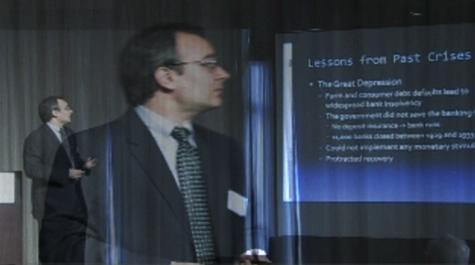Economy minefield for small business
The monumental financial crisis enveloping the world started in California with creative financing options for low-income households to purchase homes, Vladimir Atanasov, assistant professor at the Mason School of Business, told a group of Williamsburg community members Dec. 9.
Atanasov was the opening speaker for the seminar “Surviving the Credit Crunch” presented by the William and Mary Technology and Business Center in partnership with the Mason School of Business, the Greater Williamsburg Tourism Alliance and the Historic Triangle Economic Development Office.
Atanasov traced the dispersal of these subprime and Alt-A loans, which peaked in 2006 at more than $600 billion and represented more than 20 percent of all U.S. mortgages, throughout the global financial system. Independent brokers in the United States profited from the origination of these loans because they received a percentage up front based on the loan amount and, therefore, had little concern for loan quality or potential of repayment, he said. “Wall Street then securitized these loans using complicated financial engineering techniques up to the point where these loans ended up in the portfolios of institutions ranging from Dutch Pension Funds to small cooperative institutions throughout the world,” he said.
Prior to the meltdown, securities based on these subprime loans even were sold to money-market funds via creative financial entities called SIVs, Atanasov continued. These financial structures, he said, “exacerbated the problem by combining the poor credit quality of their assets with the large liquidity risks of their liabilities.” In August 2007, money-market funds, spooked by increased delinquencies of sub-prime loans, fled the markets and caused most sponsoring banks to absorb all the subprime assets of their SIVs and incur losses currently amounting to $1 trillion, he said.
In the months following, ripple effects have led to the disappearance of investment banks as institutions. Goldman Sachs and Morgan Stanley have converted to bank-holding companies, Lehman Brothers is bankrupt (the size of the Lehman Bros. bankruptcy is larger than the sum of all bankruptcies in the United States since 1998, he said), Bear Stearns was acquired at essentially fire-sale rates by J.P. Morgan, and Merrill Lynch was acquired by Bank of America, Atanasov said. In addition, the government now controls the largest participants in the mortgage securitization industry—Freddie Mac and Fannie Mae—and the largest insurance company in the world, American International Group (AIG), he said.
Funds committed by the U.S. government to battle the effects of the crisis currently exceed $7 trillion, according to Atanasov, who argued that commitment of that money is well conceived. He pointed out that a mistake by fiscal leaders during the Great Depression was to let the U.S. banking system collapse to the point where 11,000 banks closed their doors between 1929 and 1933, which led to a worse recession and longer-recovery period. As he spoke, Atanasov detailed the different programs initiated by the U.S. government to save the U.S. banking system during the current crisis.
In a word to local businesspersons attending the seminar, Atanasov said, “Management of working capital is a matter of survival. Even though Wall Street didn’t do it correctly doesn’t mean that you can’t,” he told the group of business and community leaders.
The event also featured Mason School associate professor of Hector Guerrero, who led a panel discussion with local financial institutions on the strategies and tactics local businesses can use moving forward and a second panel discussion moderated by William Bean, director of the Technology and Business Center on the wide range of services available to businesses in the Greater Williamsburg area.
Atanasov specializes in money and debt markets and financial management. He provided the group with a “layman’s guide” to Wall Street’s recent financial meltdown, detailing how the crisis had dismantled the United State’s financial infrastructure. Acknowledging comparisons of recent financial difficulties to the Great Depression he offered some hope.
“There was a lot of gross mismanagement by the U.S. Government in the Great depression that we don’t have today,” Atanasov said.
Still, he warned the economic forecast warranted caution.
“Spend every dollar as if it were your last,” he told the attending businesspersons.
















